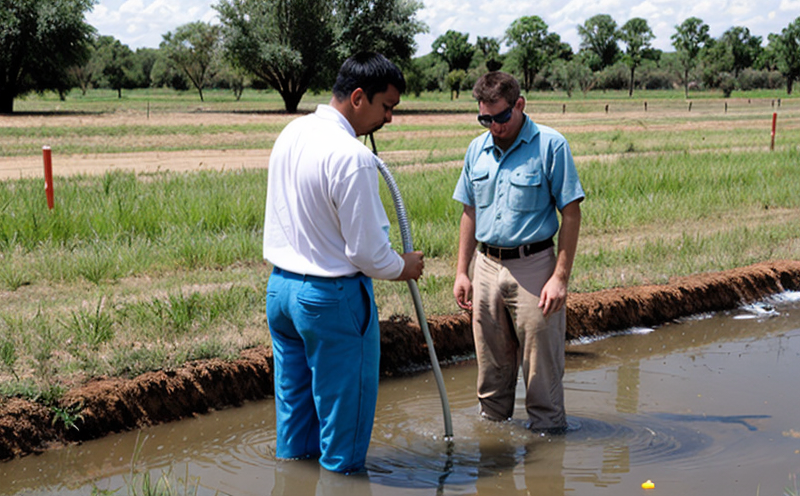APHA 2540C Total Dissolved Solids TDS Test in Groundwater
The APHA 2540C method is a widely accepted protocol used to determine the total dissolved solids (TDS) content in water samples. This test measures all the inorganic and organic substances that are not readily removed by filtration, providing a comprehensive overview of the solute content within the groundwater. TDS is an essential parameter for monitoring water quality and ensuring compliance with environmental regulations.
Groundwater plays a critical role in sustaining ecosystems and supporting human activities such as agriculture, drinking water supplies, and industrial processes. The presence of excessive dissolved solids can lead to various issues including scaling in pipes, corrosion of equipment, and potential health hazards if the levels are too high for potable use. Therefore, regular monitoring of TDS is crucial.
The APHA 2540C method involves the following steps:
- Collection of water samples from the aquifer using appropriate containers to prevent contamination.
- Precise weighing of a known volume of water sample in a pre-weighed beaker.
- Vacuum drying the beaker and its contents at 103°C ± 2°C for 4 hours, followed by cooling under desiccant.
- Weighing the dried beaker with the residual solids to determine the mass of total dissolved solids.
The primary instrument used in this test is an analytical balance capable of high precision. The accuracy and reproducibility of results are highly dependent on proper sample preparation, calibration of instruments, and adherence to standard operating procedures (SOPs). Compliance with ISO 17025 standards ensures the reliability and validity of laboratory testing.
The APHA 2540C method is particularly useful in assessing groundwater quality for various applications including agricultural irrigation, industrial processes, and potable water supply. It helps identify potential contamination sources such as septic systems, industrial discharges, or natural mineralization. Groundwater TDS levels are also a key indicator of ecosystem health, influencing the habitat suitability for aquatic organisms.
Understanding the TDS content in groundwater is vital for stakeholders involved in environmental protection and resource management. For instance, water treatment plants rely on accurate TDS measurements to optimize purification processes, reducing operational costs while ensuring safe drinking water. Similarly, agricultural operations use TDS data to determine suitable irrigation strategies that enhance crop productivity without causing soil salinization.
The significance of the APHA 2540C method extends beyond mere analytical capabilities; it serves as a cornerstone for environmental sustainability initiatives. By providing precise measurements of total dissolved solids, this methodology supports regulatory compliance and informs decision-making processes aimed at preserving natural resources and mitigating anthropogenic impacts on groundwater.
Industry Applications
The APHA 2540C method finds extensive application across multiple industries where water quality plays a pivotal role. Agriculture, particularly large-scale irrigation projects, benefits from regular TDS testing to optimize soil and plant health, thereby enhancing crop yields without compromising environmental integrity.
- Agriculture: Monitoring TDS helps in selecting appropriate crops for specific soil conditions, optimizing irrigation practices, and preventing soil degradation due to salinity buildup.
- Water Treatment Plants: Accurate TDS measurements guide the design and operation of treatment processes, ensuring the production of high-quality potable water while minimizing waste generation.
- Industrial Processes: Industries like food processing, pharmaceuticals, and electronics depend on precise TDS control to maintain product quality and comply with industry-specific standards.
In the context of environmental protection, TDS testing is instrumental in identifying areas prone to contamination and tracking changes over time. This information supports targeted interventions aimed at restoring degraded environments and promoting sustainable land use practices.
Moreover, the APHA 2540C method facilitates compliance with international standards such as ISO 17025, which ensures that laboratory testing adheres to stringent quality control measures. By leveraging this standardized approach, stakeholders can build trust among consumers and regulatory bodies, reinforcing their commitment to environmental stewardship.
International Acceptance and Recognition
The APHA 2540C method enjoys widespread acceptance across various countries due to its robustness and reliability. It is recognized by numerous international standards organizations including the American Public Health Association (APHA), ASTM International, and ISO.
- ISO: The APHA 2540C method aligns with ISO 17025 for quality management systems in testing laboratories, ensuring consistent and accurate results.
- ASTM: Compliance with ASTM E1968 underscores the precision and accuracy of TDS determinations using this methodology.
- EN: The method is also referenced in European standards like EN 14372, providing a harmonized approach to water quality assessment across Europe.
The global recognition of the APHA 2540C method fosters cross-border collaboration and standardization efforts. Laboratories from different countries can confidently adopt this protocol knowing that their findings will be universally understood and accepted. This interoperability enhances data exchange among researchers, policymakers, and industry professionals.
Moreover, adherence to international standards like ISO 17025 ensures that laboratories providing TDS testing services meet stringent quality criteria. This not only builds credibility but also facilitates seamless integration into international projects and initiatives focused on environmental sustainability.
Use Cases and Application Examples
| Use Case | Description |
|---|---|
| Agricultural Irrigation Optimization | Determine TDS levels to select crops suitable for irrigation, optimize water use, and prevent soil salinization. |
| Water Treatment Plant Operations | Monitor incoming raw water quality to adjust treatment processes and ensure potable water compliance. |
| Industrial Process Control | Control TDS in process waters for consistent product quality and adherence to regulatory standards. |
| Environmental Monitoring | Track changes in groundwater TDS over time to identify contamination sources and assess ecosystem health. |
| Sustainable Land Use Planning | Identify areas prone to contamination through regular TDS testing, guiding land use decisions for conservation efforts. |
| Pharmaceutical Manufacturing | Ensure water quality meets stringent requirements for drug production and formulation processes. |
| Electronics Manufacturing | Control process water quality to prevent contamination of sensitive electronics during manufacturing and assembly. |
The APHA 2540C method is integral to numerous real-world scenarios, from agricultural fields to industrial plants. By providing precise TDS measurements, this methodology supports informed decision-making processes that prioritize environmental protection and resource efficiency.





